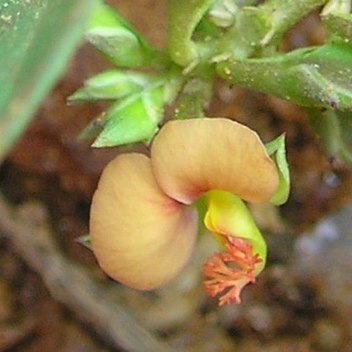Perennial, erect or ascending, mostly branched herb or undershrub up to 75 cm high, becoming woody at base, with a thickened root crown. Stem terete, becoming woody at base, set with curved short hairs and with straight long hairs. Leaves very variable, from broadly elliptic to lanceolate, 5-65 by 2-20 mm, shortly petioled, acute to mucronate, with slightly recurved margin, sparsely shortly hairy, few-nerved. Racemes supra-axillary, up to 1.5 cm long, few-flowered and cluster-like. Bracts caducous before or during anthesis, minute, lanceolate, ciliate. Flowers c. 4.5 mm long, white with green alae. Sepals lanceolate, acuminate and with a long mucro, ciliate, alae asymmetric, 5-nerved. Upper petals spathulate, about as long as the keel, inside hairy in basal half; keel more or less auriculate, with 2 bundles of filiform appendages. Filaments ± halfway free. Ovary orbicular, emarginate, ciliate; style strongly curved in the apical half, subapically strongly re-flexed with the stigmatic lobe inside. Capsule shorter but somewhat wider than the alae, c. 4 by 4 mm, somewhat asymmetrically orbicular, notched, with a narrow distinctly ciliate wing. Seed ovoid, at micropylar side with an unequally 3-lobed aril, black, hairy.
An erect and slightly branched slender herb. The leaves are alternate and rarely in a ring around the stem. They are without a leaf like appendage at the base of the leaf stem. The flowers are at the ends or in the axils of branches. They are short long spikes or on short equal stalks equally placed along the central stem. The sepals usually remain on the plant. They are unequal and the 2 inner ones are large and like petals. The ovary has 2 cells and the ovules and one their own. The capsule is 2 celled and 2 seeded and small with separate cavities.

